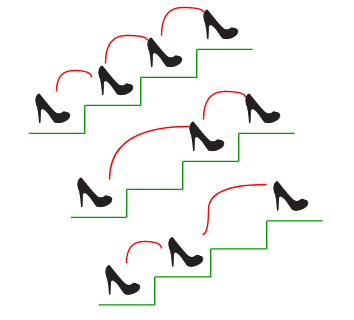有n个楼梯,一个站在底部的人想到达顶部。此人可以一次爬1阶或2阶。数一数,人就可以达到顶峰。

考虑图中所示的示例。 n的值是3。有3种方法可以到达顶部。该图取自更简单的斐波那契难题
例子:
Input: n = 1
Output: 1
There is only one way to climb 1 stair
Input: n = 2
Output: 2
There are two ways: (1, 1) and (2)
Input: n = 4
Output: 5
There are five ways: (1, 1, 1, 1), (1, 1, 2),
(2, 1, 1), (1, 2, 1), (2, 2)
方法1 :递归。
方法:在上述问题中,我们可以轻松地找到递归性质。人可以从第(n-1)个楼梯或从第(n-2)个楼梯到达第n个楼梯。因此,对于每个楼梯N,我们试图找出方法来达到N-1个楼梯和n-2个楼梯,并添加他们给第n个楼梯答案的数量。因此,这种方法的表达式为:
ways(n) = ways(n-1) + ways(n-2)上面的表达式实际上是斐波那契数的表达式,但是有一点要注意,Ways(n)的值等于fibonacci(n + 1)。
ways(1) = fib(2) = 1
ways(2) = fib(3) = 2
ways(3) = fib(4) = 3
为了更好地理解,让我们参考下面的递归树:
Input: N = 4
fib(5)
'3' / \ '2'
/ \
fib(4) fib(3)
'2' / \ '1' / \
/ \ / \
fib(3) fib(2)fib(2) fib(1)
/ \ '1' / \ '0'
'1' / '1'\ / \
/ \ fib(1) fib(0)
fib(2) fib(1)
因此,我们可以使用斐波那契数的函数来查找Ways(n)的值。
以下是上述想法的实现。
// A C program to count number of
// ways to reach n't stair when
// a person can climb 1, 2, ..m stairs at a time.
#include
// A simple recursive program to find
// n'th fibonacci number
int fib(int n)
{
if (n <= 1)
return n;
return fib(n - 1) + fib(n - 2);
}
// Returns number of ways to reach s'th stair
int countWays(int s)
{
return fib(s + 1);
}
// Driver program to test above functions
int main()
{
int s = 4;
printf("Number of ways = %d", countWays(s));
getchar();
return 0;
}
Number of ways = 5
复杂度分析:
- 时间复杂度: O(2 ^ n)。
- 与上述方法一样,我们正在执行多余的计算,例如发现fib(3)的次数超过’1’。这将其时间复杂度提高到了指数级。
- 可以使用前面讨论的Fibonacci函数优化将其优化为O(Logn)时间。
辅助空间: O(1)。
由于没有使用额外的数据结构来存储值,因此:
上述问题的概括
如果一个人可以在给定的值m上爬上m个楼梯,该如何计算路数。
例如,如果m为4,则该人可以一次爬1阶或2阶或3阶或4阶。
方法:对于以上方法的概括,我们可以使用以下递归关系。
我们可以将重复写成如下形式。
ways(n, m) = ways(n-1, m) + ways(n-2, m) +
... + ways(n-m, m)
在这种到达楼梯“ n”的方法中,我们尝试从当前楼梯爬上所有小于等于“ n”的楼梯。
// A C program to count number of
// ways to reach n't stair when
// a person can climb either 1 or 2
// stairs at a time
#include
// A recursive function used by countWays
int countWaysUtil(int n, int m)
{
if (n <= 1)
return n;
int res = 0;
for (int i = 1; i <= m && i <= n; i++)
res += countWaysUtil(n - i, m);
return res;
}
// Returns number of ways to reach s'th stair
int countWays(int s, int m)
{
return countWaysUtil(s + 1, m);
}
// Driver program to test above functions-
int main()
{
int s = 4, m = 2;
printf("Nuber of ways = %d", countWays(s, m));
return 0;
}
Nuber of ways = 5
复杂度分析:
- 时间复杂度: O(2 ^ n)。
- 与上述方法一样,我们正在执行冗余计算,例如发现fib(3,2)的次数超过“ 1”,这将其时间复杂度提高到了指数级。
- 可以使用动态编程将其优化为O(m * n)。我们以自底向上的方式构建表’res []’。
- 辅助空间: O(1)。
o使用任何数据结构来存储值。
方法2 :动态编程。
方法:该方法使用动态编程技术来解决。
方法:我们使用以下关系以自底向上的方式创建表res [] :
res[i] = res[i] + res[i-j] for every (i-j) >= 0
使得阵列的第i个指数将包含的路的数目需要达到第i个步骤考虑攀登的所有可能性(即,从1到i)。
下面的代码实现了上述方法:
// A C program to count number
// of ways to reach n't stair when
// a person can climb 1, 2, ..m
// stairs at a time
#include
// A recursive function used by countWays
int countWaysUtil(int n, int m)
{
int res[n];
res[0] = 1;
res[1] = 1;
for (int i = 2; i < n; i++) {
res[i] = 0;
for (int j = 1; j <= m && j <= i; j++)
res[i] += res[i - j];
}
return res[n - 1];
}
// Returns number of ways to reach s'th stair
int countWays(int s, int m)
{
return countWaysUtil(s + 1, m);
}
// Driver program to test above functions
int main()
{
int s = 4, m = 2;
printf("Nuber of ways = %d", countWays(s, m));
return 0;
}
Nuber of ways = 5
复杂度分析:
- 时间复杂度: O(m * n)。
对于每个楼梯,我们检查所有可能性“ m”,楼梯数为“ n”。 - 辅助空间: O(n)。
使用数组存储中间值。
请参阅有关到达第n个楼梯的计数方法的完整文章,以了解更多详细信息!
想要从精选的最佳视频中学习和练习问题,请查看《基础知识到高级C的C基础课程》。